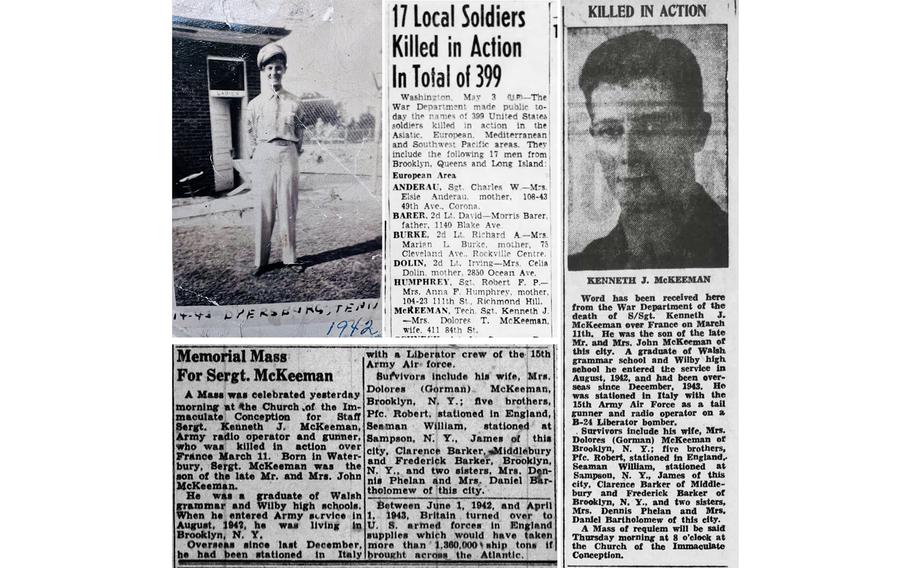
The remains of U.S. Army Air Force Tech. Sgt. Kenneth J. McKeeman are to be buried with full military honors in Middletown, Conn., in June. (Defense POW/MIA Accounting Agency)
(Tribune News Service) — The remains of a World War II soldier from Waterbury who was killed along with his entire bomber crew in 1944 have been identified and will be buried with full military honors in Middletown, a U.S. Department of Defense agency announced this week.
U.S. Army Air Force Tech. Sgt. Kenneth J. McKeeman was identified from remains exhumed from the Rhône American Cemetery in Draguignan, France, the Defense POW/MIA Accounting Agency (DPAA) announced. McKeeman is to be buried in the State Veterans Cemetery on June 7.
In early 1944, McKeeman, 23, was assigned to the 724th Bombardment Squadron, 451st Bombardment Group, 15th Air Force in the Mediterranean and European Theater. On March 11, he was serving as a bombardier on a B-24D “Liberator” that took off from San Pancrazio Airfield in Italy carrying 11 crew members for a mission against Toulon on the southern coast of France.
Powered by four Pratt & Whitney engines, the Consolidated B-24 Liberator is described on the National World War II Museum site as “a powerful symbol of US industrial might, with more than 18,000 produced by the war’s end.” The plane was a workhorse, flying faster, higher and farther than the older B-17 bombers. All heavy bomber crews, however, suffered heavy losses throughout the war. The National Museum of the United States Air Force lists more than 30,000 crew members killed, 30,000 captured, 10,000 wounded, and 8,000 planes lost.
After dropping its payload, McKeeman’s Liberator took a direct hit from German flak just behind the rear bomb bay, according to the DPAA.
“Others flying the mission reported seeing a large burst of flame shooting through the damaged Liberator’s waist windows before the aircraft fell out of control and broke in half,” the agency reported. “The two sections of the plane fell into the water. Witnesses reported seeing no parachutes before the crash and believed that there were no survivors.”
German forces in the area found the crash site near Cape Cépet and recovered several sets of remains, which were then interred in the Lagoubran Cemetery in France. Beginning in 1945, the American Graves Registration Command exhumed 25 graves from the cemetery. Among the recovered remains were some of McKeeman’s fellow crewmen and four unknowns. The remains of the unknown service members ultimately were interred in Rhône American Cemetery.
DPAA historians and American Battle Monuments Commission personnel exhumed remains identified as X-85 in 2019 and transferred them to the agency’s laboratory. Scientists identified McKeeman in part through mitochondrial DNA analysis, the agency said.
McKeeman was born in Waterbury, graduated from Wilby High School and entered service in 1942, according to news articles at the time of his death. He left a wife, Dolores Gorman McKeeman, whom his nephew said he married while on furlough; five brothers, two of whom were serving in the war; and two sisters, according to the Waterbury newspapers. A Mass was celebrated at the Church of the Immaculate Conception in Waterbury upon news of his death.
McKeeman’s nephew, Michael McKeeman of Litchfield, said he and other family members plan to attend the funeral. McKeeman, 72, said he and two female cousins provided DNA to help researchers identify his uncle’s remains. Michael McKeeman’s father, William McKeeman, served in the U.S. Navy in the Pacific during the war, and his uncle Robert served in Europe. He said his father and uncle did not talk much about the war or their brother’s death, so he has learned much in the identification process. McKeeman said he is thankful to the Department of Defense researchers.
“The resources and commitment they’ve given to this are beyond remarkable,” he said.
Kenneth McKeeman’s name is recorded on the Walls of the Missing at Rhône American Cemetery, along with others still missing from World War II. A rosette will be placed next to his name to show he has been accounted for, the DPAA said.
For more information on the Defense Department’s mission to account for Americans who went missing while serving, people can visit www.dpaa.mil.
(c)2024 Journal Inquirer, Manchester, Conn.
Visit Journal Inquirer
Distributed by Tribune Content Agency, LLC.